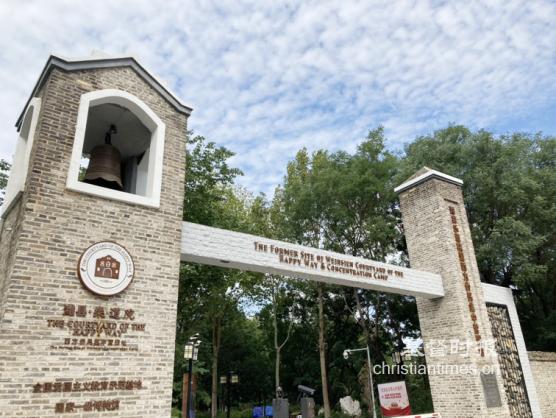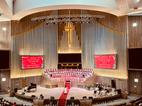September 3rd this year marks the 76th anniversary of the victory of the Chinese people’s Anti-Japanese War and the World Anti-fascist War. On the eve of the anniversary, I had the honor to visit - in Shandong Province - The Courtyard of the Happy Way and the former site of Wei County (Weihsien) Concentration Camp of western expatriates which is known to the world as the Auschwitz in the East.
When talking about “concentration camps”, many people would think of the genocidal Auschwitz concentration camp in Poland carried out by German fascists against Jews during World War II. The Courtyard of the Happy Way and the concentration camp in the East recorded the inhuman days of imprisoned western expatriates in the dark.
The Courtyard of the Happy Way is located between Yuhe Road and Yuanfei Road in Kuiwen District, Weifang City, Shandong, on the south bank of Yuhe River along with several scattered dark grey European buildings.
During the Japanese invasion of China, 2,008 European and American expatriates were detained here.
According to the records of Weifang City, in 1882, Rev. Robert M. Mateer, M.D. from the Presbyterian Church in the United States, came to Wei County to preach with his wife Asherah (once called Di Zhenzhu). With the assistance of local members, he bought land at the East Gate of the old Wei County (formerly known as Weihsien) to establish The Courtyard of the Happy Way (referred to as the Courtyard below). The Courtyard was made of three parts: church, school, and clinic. At that time, the Courtyard was a Christian service center integrating church, education, and medical treatment in the Changwei area, and it was also one of the activity centers where western missionaries, teachers, businessmen, scholars, and medical workers gathered.
After the outbreak of the Pacific War, Japan retaliated against the United States for restricting the activities of Japanese-Americans in the United States. In March 1942, the Japanese army set up an alien concentration camp in Wei County and imprisoned 2008 European and American expatriates (later, 500 were released by exchanging prisoners of war), including 327 children. The detainees included Raymond J. de Jaegher, the American who served as Chiang Kai-shek’s adviser; Dr. Watson Hayes, Dean of North China Theological Seminary; Dr. De Weisi (original name could not be found, translator’s note), Director of Teaching Affairs of Cheeloo University; Arthur W. Hummel Jr., teacher of The Affiliated Middle School of Fu Jen Catholic University, who later served as American ambassador to China; and Eric Liddel, the famous Scottish 400-meter sprint champion of the 1924 Paris Olympic Games, who later came to China for missionary ministry.
In the concentration camp, the western missionaries suffered along with the Chinese people.
Eric Liddell, the famous British athlete who won the 400-meter gold medal at the 1924 Paris Olympic Games came to China for missionary work. He was detained in the concentration camp of the Courtyard for a long time. In the minds of the children in the camp, the Olympic champion was the embodiment of happiness and light. In addition to organizing children to play various games and sports competitions, he also managed the daily life affairs of his fellow detainees between the two sites. Every morning and evening, he ensured that all people attend the roll call. He organized daily matters such as water, coal, garbage, room cleaning. He also helped children with their homework in the evening.
Less than 200 days before the liberation of the camp, Liddell, the Olympic champion, forever left the world he loved as he could not get timely treatment for a brain tumor. The weather on the day of his funeral was extremely cold, but almost everyone in the camp attended his funeral.
In December 1941, the Japanese attacked Pearl Harbor triggering the Pacific War, and countries such as Britain and the United States declared war on Japan. Thus, all Westerners in China became enemies of Japan. On the second day of the Pearl Harbor incident, Japanese troops came to Chefoo School (also known as China Inland Mission School) and claimed to take over the school. Mary Taylor Previte (the great-granddaughter of Hudson Taylor), who was only 9 years old at that time, became a prisoner. In November 1942, more than 300 teachers and students at Chefoo School were detained in the camp of Yantai Yuhuangding (original name could not be found) Presbyterian Church. In the summer of 1943, they were transferred to the Courtyard camp in Wei County.
Mary Taylor Previte recalled that the teachers led the students to study through games in the camp, and she described the teacher’s behaviors as a “beautiful victory”. In this way, under the condition of severe nutritional deficiency the teachers miraculously managed three graduations. As always, they adhered to the strict standards of the Oxford examination system.
On August 17, 1945, a B24 plane sent by the U.S. military aid headquarters in China arrived over Wei County camp. Seven fully armed U.S. soldiers parachuted from the sky liberating the people there. A few weeks later, Mary Taylor Previte and her brothers and sisters flew to Xi’an to reunite with their parents whom they had not seen for five years.
In A Song of Salvation at Weihsien Prison Camp, Mary wrote more specifically about life in the camp. For instance, on Sunday morning, there was a Catholic Mass Eucharist, and at 11: 00, there was worship from the Anglican Church and the United Church. The evening prayer program was mainly songs and worships. Every Easter, worship and memorial programs began at dawn. The performances in the church were endless all year round. The entertained audiences could temporarily forget those police dogs, iron power grids, smelly toilets, and hunger.
On June 25, 1900, Chen Shuangchen (also known as Chen Xiqing), leader of the Boxer Rebellion of the Wei County division, led his gangs to set the Courtyard on fire, burning 42 buildings and 136 bungalows. The church and other main buildings were burnt into ashes. In 1902, Robert McCheyne Mateer used the boxer refund, the Qing government compensation, and all the funds donated by the American churches to rebuild and expand the Courtyard. During this period, they led people to learn God’s Word while doing medical service and education.
During Japan’s invasion of China, about 2,000 missionaries and western expatriates were detained in the Courtyard. They suffered and even sacrificed together with the Chinese people and survived the most difficult period.
- Translated by Charlie Li








